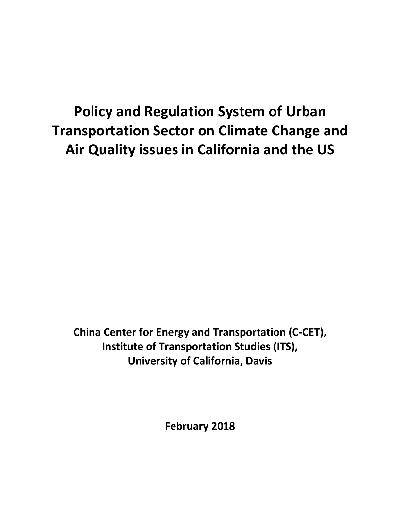"GHG"相关数据
更新时间:2020-11-18Introduction
There are increasing concerns around the globe about pollution and its impact on air qualityand climate change. United States is currently the second largest contributor to worldwide Carbon dioxide emissions at 15%. Transportation sector is one of the largest causes of air pollution and emission in United States. It contributes 27% of the total Greenhouse gas emissions in 2015. Between 2990 and 2015, GHG emissions in the transportation sector increased more in absolute terms than any other sector due in large part to increased demand for travel.Consequently, Federal government of the United States as well as state governments have created legislation and standards for transportation sector to improve air quality and to combat climate change. For example, from vehicle side, in 2010 EPA and National Highway Traffic Safety Administration (NHTSA) establish a 35.5-mpg standard for new light-duty vehicles by 2016. The following year, EPA and NHTSA proposed additional rules for a 54.5- mpg standard by 2025, and adopted additional GHG and fuel economy standards for other types of vehicles. At State and Local government levels, twenty-three states have adopted GHG reduction targets;35 states have developed climate action plans.
500 mayors have signed the U.S. Conference of Mayors' Climate Protection Agreement. Many state and local governments are implementing transportation strategies to reduce GHG, such as S.B. 375, California's legislation on land use and transportation planning, etc. It is commonly agreed that transportation air pollution and GHG reduction can be achieved from five areas include Vehicles, Fuels, Vehicle Miles Traveled (VMT), Operational Efficiency, and Construction, Maintenance, and Agency Operations. The previous efforts on combating air pollution and GHG reduction were heavily focused on the first two areas. But growing attention has been shifted to VMT as growth in travel could present a challenge to achieving environmental targets. If people travel more, especially on private cars, higher VMT and higher GHG emissions are generated. VMT per capita are higher in the US than in Europe and Canada. Even if future per-capita VMT stays flat, total VMT in the US still would grow at about 1% per year because of population growth, offsetting some of the technological improvements invehicles and fuels.
So, this report summarizes a number of legislations and plans on federal, state as well as local level that aiming to improve the efficiency and quality of public transportation, with a focus on public transit, as well as its interaction with biking/walking and integration with land use. The improvement of public transportation will help shift the travel from high emission private cars to cleaner transportation ways, thus reduce the emission from transportation sector.
【更多详情,请下载:美国公共交通领域应对气候变化及提升空气质量相关法律法规】

 1990-2017年全球GHG净排放量:LUCF清除量(公吨二氧化碳当量)该数据包含了1990-2017年GHG净排放量:LUCF清除量(公吨二氧化碳当量)。中国1994为-407.479。1990-2017年发布时间:2020-07-16
1990-2017年全球GHG净排放量:LUCF清除量(公吨二氧化碳当量)该数据包含了1990-2017年GHG净排放量:LUCF清除量(公吨二氧化碳当量)。中国1994为-407.479。1990-2017年发布时间:2020-07-16 1990-2009年全球164个国家和地区GHG净排放量/LUCF清除量(公吨二氧化碳当量)该数据包含了1990-2009年全球164个国家和地区GHG净排放量/LUCF清除量(公吨二氧化碳当量)。阿尔巴尼亚1994年为1.5255(公吨二氧化碳当量)。1990-2009年发布时间:2020-11-18
1990-2009年全球164个国家和地区GHG净排放量/LUCF清除量(公吨二氧化碳当量)该数据包含了1990-2009年全球164个国家和地区GHG净排放量/LUCF清除量(公吨二氧化碳当量)。阿尔巴尼亚1994年为1.5255(公吨二氧化碳当量)。1990-2009年发布时间:2020-11-18 1961-2050年全球223个国家和地区燃烧作物残留物一氧化二氮的排放量Greenhouse Gas (GHG) emissions from burning crop residues consist of methane (CH4) and nitrous oxide (N2O) gases produced by the combustion of a percentage of crop residues burnt on-site. The mass of fuel available for burning should be estimated taking into account the fractions removed before burning due to animal consumption, decay in the field, and use in other sectors (e.g., biofuel, domestic livestock feed, building materials, etc.). FAOSTAT emission estimates are computed at Tier 1 following the IPCC 2006 Guidelines for National GHG Inventories (http:∕∕www.ipcc-nggip.iges.or.jp∕public∕2006gl∕vol4.html). GHG emissions are provided by country, reguions and special groups, with global coverage, relative to the period 1961-present (with annual updates) and with projections for 2030 and 2050, expressed both as Gg CH4, Gg N2O, Gg CO2eq and CO2eq from CH4 and N2O, by crop (maize, rice, sugarcane and wheat) and by aggregates. Implied emission factors for N2O and CH4 as well activity data (biomass burned) are also provided.1961-2050年发布时间:2020-06-12
1961-2050年全球223个国家和地区燃烧作物残留物一氧化二氮的排放量Greenhouse Gas (GHG) emissions from burning crop residues consist of methane (CH4) and nitrous oxide (N2O) gases produced by the combustion of a percentage of crop residues burnt on-site. The mass of fuel available for burning should be estimated taking into account the fractions removed before burning due to animal consumption, decay in the field, and use in other sectors (e.g., biofuel, domestic livestock feed, building materials, etc.). FAOSTAT emission estimates are computed at Tier 1 following the IPCC 2006 Guidelines for National GHG Inventories (http:∕∕www.ipcc-nggip.iges.or.jp∕public∕2006gl∕vol4.html). GHG emissions are provided by country, reguions and special groups, with global coverage, relative to the period 1961-present (with annual updates) and with projections for 2030 and 2050, expressed both as Gg CH4, Gg N2O, Gg CO2eq and CO2eq from CH4 and N2O, by crop (maize, rice, sugarcane and wheat) and by aggregates. Implied emission factors for N2O and CH4 as well activity data (biomass burned) are also provided.1961-2050年发布时间:2020-06-12 1961-2050年全球261个国家和地区牧场上所有动物的粪便间接排放一氧化二氮的量残留在牧场上的粪便产生的GHG排放物包括通过放牧牲畜而残留在牧场上的粪便氮(N)产生的直接和间接一氧化二氮(N2O)排放。具体而言,N2O是通过微生物的硝化和反硝化过程产生的。沉积场所(直接排放),以及在挥发∕再沉积和浸出过程之后(间接排放)。1961-2050年发布时间:2020-07-09
1961-2050年全球261个国家和地区牧场上所有动物的粪便间接排放一氧化二氮的量残留在牧场上的粪便产生的GHG排放物包括通过放牧牲畜而残留在牧场上的粪便氮(N)产生的直接和间接一氧化二氮(N2O)排放。具体而言,N2O是通过微生物的硝化和反硝化过程产生的。沉积场所(直接排放),以及在挥发∕再沉积和浸出过程之后(间接排放)。1961-2050年发布时间:2020-07-09 1961-2050年全球262个国家和地区牧场上所有动物的粪便直接排放一氧化二氮的量残留在牧场上的粪便产生的GHG排放物包括通过放牧牲畜而残留在牧场上的粪便氮(N)产生的直接和间接一氧化二氮(N2O)排放。具体而言,N2O是通过微生物的硝化和反硝化过程产生的。沉积场所(直接排放),以及在挥发∕再沉积和浸出过程之后(间接排放)。1961-2050年发布时间:2020-07-09
1961-2050年全球262个国家和地区牧场上所有动物的粪便直接排放一氧化二氮的量残留在牧场上的粪便产生的GHG排放物包括通过放牧牲畜而残留在牧场上的粪便氮(N)产生的直接和间接一氧化二氮(N2O)排放。具体而言,N2O是通过微生物的硝化和反硝化过程产生的。沉积场所(直接排放),以及在挥发∕再沉积和浸出过程之后(间接排放)。1961-2050年发布时间:2020-07-09





